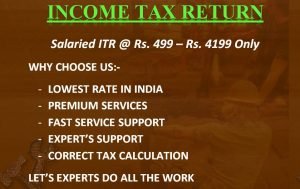Description
What is TDS?
TDS (Tax Deducted at Source) is an indirect system of deduction of tax according to the Income Tax Act, 1961 at the point of generation of income. Tax is deducted by the payer and is remitted to the government by him on behalf of the payee.
A TDS Return is a quarterly statement which has to be submitted to the Income Tax Department of India. Submitting TDS Return is mandatory if you are a deductor. It has details of TDS deducted and deposited by you.
What is TDS Return?
Apart from depositing the tax, the deductor should also file a TDS return.
TDS return is a quarterly statement to be given to the IT department. It is compulsory for deductors to submit a TDS return on time. The details required to file TDS returns are:
- PAN of the deductor and the deductee
- Amount of tax paid to the government
- TDS challan information
- Others, if any
Due Dates for Payment of TDS
| Amount paid/credited | Due date of TDS deposit | |
| Government Office | Without Challan | Same Day |
| With Challan | 7th of next month | |
| On perquisites opt to be deposited by employer | 7th of next month | |
| Others | In month of March | 30th April |
| In other months | 7th of next month |
TDS Return Forms
| Particulars | Form No. |
| TDS on Salary | Form 24Q |
| TDS where deductee is a non-resident, foreign company | Form 27Q |
| TDS on payment for transfer of immovable property | Form 26QB |
| TDS in any other case | Form 26Q |
TDS Return Filing
Due dates of TDS Return FY 2018-19 :| Quarter | Quarter Period | TDS Return Due Date |
| 1st Quarter | 1st April to 30th June | 31st August 2018 |
| 2nd Quarter | 1st July to 30th September | 31st October 2018 |
| 3rd Quarter | 1st October to 31st December | 31st January 2019 |
| 4th Quarter | 1st January to 31st March | 31st May 2019 |
Details required in the GSTR-9 form
Serial Number | Parts of the GSTR-9 | Information required |
| 1 | Part-I | Basic details of the taxpayer. This detail will be auto-populated. |
| 2 | Part-II | Details of Outward and Inward supplies declared during the financial year(FY). This detail must be picked up by consolidating summary from all GST returns filed in previous FY. |
| 3 | Part-III | Details of ITC declared in returns filed during the FY. This will be summarised values picked up from all the GST returns filed in previous FY. |
| 4 | Part-IV | Details of tax paid as declared in returns filed during the FY. |
| 5 | Part-V | Particulars of the transactions for the previous FY declared in returns of April to September of current FY or up to the date of filing of annual returns of previous FY whichever is earlier. Usually, the summary of amendment or omission entries belonging to previous FY but reported in Current FY would be segregated and declared here. |
| 6 | Part-VI | Other Information comprising details of: |
| -GST Demands and refunds, | ||
| -HSN wise summary information of the quantity of goods supplied and received with its corresponding Tax details against each HSN code, | ||
| -Late fees payable and paid details and | ||
| -Segregation of inward supplies received from different categories of taxpayers like Composition dealers, deemed supply and goods supplied on approval basis. |
GSTR-9 Format
Frequently Asked Questions:-
– Is it mandatory to file Form GSTR-9?
Yes, it’s mandatory to file Form GSTR-9 for normal taxpayers.
– Can GSTR-9 be filed even in the case of Nil Turnover?
Yes, it is mandatory to file NIL Return.
– Can I revise the GSTR-9 which has been filed?
No. Currently, GSTR-9 does not allow for any revision after filing.
– What if your GSTN is Cancelled?
Even if your GSTN is cancelled, say during FY 2017-18, taxpayers are required to file GSTR-9.
– What if opted out or in Composition Dealer during the year?
If you have opted out or in Composition Dealer during the year, the taxpayer needs to file GSTR-9 and GSTR- 9A for the relevant periods.
– Will transactions for the period before July 2017 be included in GSTR-9?
No, transactions for the period before July 2017 will not be included in GSTR-9 because the GST authority has said that only the details for the period between July 2017 to March 2018 will be considered while filing the GSTR-9.
– Whether form GSTR-9 return is required to be filed at the entity level or GSTIN level?
Form GSTR-9 return is required to be filed at GSTIN level i.e. for each registration. If taxpayer has obtained multiple GST registrations, under the same PAN, whether in the same State or different States, he/she is required to file annual return for each registration separately, where the GSTIN was registered as a normal taxpayer for some time during the financial year or for the whole of the financial year.
– What is the Reconciliation statement in the GST Audit?
With annual audit form GSTR 9C, the taxpayer must also submit a reconciliation statement along with the GST audit certification. The reconciliation statement is the extra details given with GSTR 9C, which confirms the reconciliation of data according to GST annual return as per the accounts book and data.
– Can GSTR-9 be filed if the taxpayer has not filed GSTR-1 and GSTR-3B?
GSTR-9 cannot be filed unless GSTR-3B and GSTR-1 are filed.
– Can additional liability be paid?
Liability identified during the filing of annual return can be deposited with Government using DRC-03 Form (i.e., Liability not earlier paid through GSTR-3B)
– Can additional ITC be claimed?
ITC which is not claimed in GSTR-3B cannot be claimed in GSTR-9. Also, the same needs to be claimed in GSTR-3B upto the extended timeline for claiming input credit.















Reviews
There are no reviews yet.